
23 minute read
ESTA Viewpoint
A year for collaboration
Advertisement
Whether it’s trade shows, the UK’s leadership of the COP26, or energy sector organisations, the key to promoting the energy efficiency agenda this year will be working together, believes Mervyn Pilley
Two years into the role of executive director at ESTA, and the interesting and challenging times continue. As I write this column my own vaccination beckons and discussions are taking place about what the new normal will look like for us both as individuals, as employees and indeed as businesses.
The energy sector traditionally has a lot of trade shows in the latter months of the year and I suspect many people will be looking forward to a return of the physical events. The virtual world has enabled events and meetings to continue but the many attempts to replicate the physical trade shows that were put on in 2020 had mixed results. As humans we really do need that interaction with other human beings and unfortunately that is just not the same across computer screens.
One discussion that is happening now is about the need for future hybrid events. These will be physical events, perhaps with smaller number of attendees, supported by live streaming and virtual aspects. This may not great for the exhibitors but certainly better potentially for events and meetings. It is important to remember that it isn’t just a discussion about venues being able to accommodate numbers of people in a safe environment, but people also need to have the confidence to travel to venues, potentially on very crowded public transport.
Autumn move for aM&T event
At the moment we are looking at potentially holding our aM&T event in October/November along those lines and will keep everyone up to date as plans evolve. On the subject of events, we are hard at work planning the next ESTA Conference – Green Recovery – Action NOW! aimed at all with an interest in energy efficiency, especially end users/potential customers. Working with the Energy Institute and Energy Leeds the event will be run over three afternoons – Tuesday 20th April through to Thursday 22nd April 2021. Each day will be based around a theme as follows: • Tuesday 20th April – speakers on Government policy, COP26 as well as job

creation; • Wednesday 21st April – speakers on how technological solutions are driving higher levels of energy efficiency; and • Thursday 22nd April – speakers covering the various solutions on offer including training to help end users achieve Net Zero targets
Full details of timings and speakers for all three days will be published on the ESTA website and EiBI readers are very welcome to join us.
In my January column I mentioned COP26. I suggested then that Alok Sharma was clearly too busy doing his ‘day job’ as a minister to carry out an effective role as Chair of COP. This has now been proven to be correct with him taking on the chair role full time. The challenge for the energy sector is that those moves within BEIS has meant a new energy minister. As many other sectors have found to their cost, continuity of service from a minister is a very important aspect of policy planning for the medium to long term. We look forward to working with the new minister.
We continue to work with others to make sure that the critical importance of energy efficiency – using less energy – gets a decent hearing at the event in Glasgow. The focus has continued to be on the big projects – renewables, carbon capture and storage, EVs etc. Yes, these are indeed Mervyn Pilley is executive director of ESTA (Energy Services and Technology Association) much needed, if very expensive, projects. But using less energy is considerably less expensive, especially if behaviour change (yes, another plug for our rapidly growing Energy Conscious Organisation programme) is fully brought into play. Unfortunately, it looks highly likely that the Green Homes Grant scheme underspend on its budget for 2020-21 will be clawed back by the Treasury. Sadly, the major challenges of the scheme were predictable and a substantial amount of advice from the installer sector was not taken on board. This is a disappointing example of where Government policy in relation to energy efficiency has not been very successful. We will continue to focus on convincing the Government of the importance of a cohesive, joined-up policy programme on energy efficiency. Critically, this needs to encompass the non-domestic, commercial markets, which up to now have been effectively sidelined.
Share knowledge and innovation
The collaboration projects that we are working on continue to develop, despite the ongoing effects of lockdown/ pandemic. The Commercial Energy Efficiency Alliance, a group of trade associations and professional bodies looking to share knowledge and innovation in relation to all areas of commercial buildings including retrofit, is building slowly but surely. Our Energy Efficiency in Buildings group jointly run with the Building Engineering Services Association is meeting again this month, and some good collaboration work is underway. I was also very pleased to see the launch of Actuate UK, a major collaboration between BESA and seven other membership organisations operating in the building services engineering space. This is another great example of how membership collaboration at scale can help to solve many of the challenges we are all facing today. On the same subject we are currently in discussion with others about how trade associations can work together to help us achieve the sustainable development goals. Watch this space for more collaboration this year.
Smart Buildings
For further information on Ovarro visitwww.eibi.co.uk/enquiriesand enter ENQUIRY No. 132
Matthew Hawkridge, is chief technical officer at Ovarro
Smarter thinking cities
Matthew Hawkridge looks at how remote telemetry units can play a part in creating the smart, efficient cities that will be a global feature in the coming years
With a recent announcement that the sales of diesel and petrol cars will be banned by 2030, five years ahead of schedule, it won’t be long before even more attention is focussed on the built environment.
According to forecast from the United Nations, world population is likely to reach 9bn by 2050 (from around 7bn today). This growth will see an increase in the number of mega cities with population over 10m. Making cities smarter is one way of tackling this challenge and RTUs are a critical part of delivering this utopia.
The best way of thinking about RTUs is that they are ‘mini-computers in the field’, so adding one to an older asset can make it ‘smart’. In terms of benefits, RTUs help optimise assets in both near and remote applications – particularly useful for renewable assets that will supply these new mega cities. Their principal role is to provide monitoring and control, although functionality now goes far beyond this with an ability to collect, analyse data and then act upon it autonomously, where needed.
The principle benefit of RTUs is that they enable buildings and indeed entire cities to be remotely monitored, allowing status of a vast range of assets such as traffic lights, electrical substations, transport nodes, amongst others to be regularly verified from a laptop or smart device. RTUs gather, interpret and act upon this data. They can also monitor the external environment, for example, local temperature, which can be useful when optimising energy efficiency. The point is, specifiers may not realise it, but an RTU is able to solve many of the problems they work on in mega cities.
RTUs, such as TBox, act as both the site controller and the site communications gateway. They collect data directly, or provide a secure VPN, to PLCs used to monitor

As the trend towards megacities accelerates the need for smart solutions will become acute
the asset. The collected data is then made available to the operators who can issue commands back to the RTU to control the asset. In parallel, the RTU relays key information to the asset owner or maintenance partner. With its ability to report alarms and historical data via email, SMS and FTP, it means nominated personnel are always being updated on its status.
Digital twin involves the replication of a physical asset, process or system to create a virtual representation of the physical world, like a simulation using 3D renderings of computer-aided design (CAD) models. It can be used in smart cities to predict different outcomes based on variable data, and these can be run as simulation scenarios until the optimum outcome is identified – all within the digital space.
Data gathered by sensors
Digital twin uses real time data gathered by sensors, PLCs or RTUs to help operators better understand their assets and process, whilst identifying opportunities to increase efficiency and safety. Although data can be gathered using all three methods it is the RTU that offers the distinct advantage over PLC’s or sensors of being environmental robust – essential when tens of millions of people in a mega city rely on the systems.
Of all the pathways that data must traverse, the connection to the asset site is the one most likely to fail, and servers sitting in data centres are on the wrong side of that link. It is the RTU that sits at the true edge of your control system gathering information, providing local, low latency control, irrespective of communications connectivity.
RTUs therefore need to be resilient to environmental extremes, withstanding anything from -40oC to +70oC climatic temperatures. Having multiple, independent communications links, redundant power supplies and redundant process controllers provides another buffer to site conditions and future technological developments. Their resilient nature and layers of redundancy ensure that RTU’s are a reliable part of a mega cities support infrastructure.
Where maintenance of assets within a smart city are factored out, knowing the status of the device before the end customer ensures better outcomes for all project partners. Where the asset could potentially develop a fault that prevents it from operating, RTU’s allow maintenance teams to take preventative action. With a growing focus on the environment, ‘big data’ captured using RTUs allow accurate monitoring of emissions. In Asia, TBox RTU technology monitors diesel generator systems 24/7, providing emissions data to a central reporting location. The centralised data can be accessed by the wider community through an air quality index app on smart devices as a means of keeping their energy providers in check. In addition, for the benefit of the owner, the RTUs monitor the generator health, by tracking exhaust temperatures, heater exchange throughput and oil quality as part of proactive maintenance measures. Monitoring fuel use also benefits efficiency management and deters fuel theft.
As the world’s population grows through to 2050, RTUs will play a more prominent role in making sure these cities work efficiency. Even now, the world’s largest cities are growing at phenomenal rates and it won’t be long before they reach capacity, although RTUs are already routinely deployed. In simple terms, unless we embrace technology, these vast urban conurbations are liable to grind to a halt.
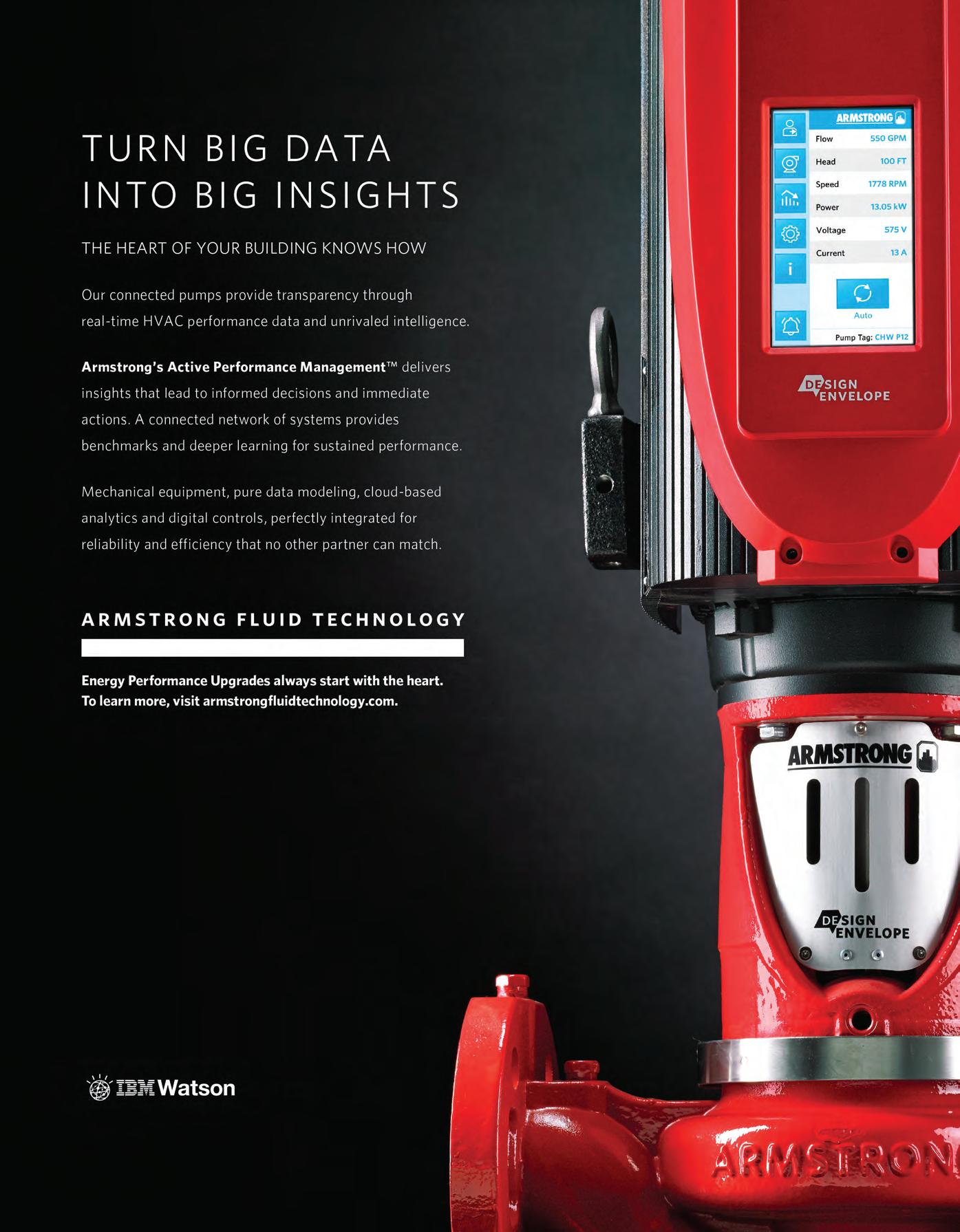
Smart Buildings
For further information on EnOcean Alliance visitwww.eibi.co.uk/enquiriesand enter ENQUIRY No. 131
Graham Martin is CEO and chairman, EnOcean Alliance

Monitor to lower the threat
Carbon dioxide sensors can go much further than monitoring indoor air quality. Graham Martin looks at how they could give a first warning about the spread of coronavirus
There is increasing evidence that carbon dioxide levels in buildings correlate strongly with the airborne spread of infection. Consequently, CO2 monitors could act as the “canary in the coal mine” to mitigate the coronavirus threat.
Carbon dioxide is generated by the exhaled air of people who stay indoors. Each person in a building will exhale approximately eight litres of air per minute: air that has been in close contact with the lung tissue. Alongside CO2 at a concentration around 40,000 parts per million (ppm), the exhalation also contains tiny liquid droplets (aerosols) which, due to their size, can float in the air for a long time. These droplets will contain any virus particles present in the lungs. Research shows a method to mitigate infection can be implemented with CO2 monitors on site. While it is difficult to measure the viral load directly, energy harvesting wireless sensors are the ideal way to monitor CO2 levels and hence prevent the build-up of reused air.
With evidence pointing towards airborne transmission being a major factor in the spread of the virus, the inference is that CO2 levels in rooms and other enclosed spaces may be used as a proxy for COVID-19 transmission risk.
Indoor CO2 measurements using easy and low-cost to install sensors hold promise for mass monitoring of indoor aerosol transmission risk for Covid-19 and other respiratory diseases. Different CO2 level targets should be set based on the environment and activity type, since infection risk level has been shown to vary by a factor of 100 or more depending on the situation and activity type. Factors such as the number of infected people in a region, and measures such as mask-wearing or air filtration may reduce presence of the airborne virus without reducing CO2 levels. Certain activities increase virus emission far more than CO2 levels, such as talking, singing and shouting. Both CO2 and the virus are diluted by ventilation with outdoor air. They are not, however removed by recirculating the air, for example through heat exchangers
If we are in a room with several people, the measurement of the CO2 concentration provides a measure of what percentage of the air we inhale which consists of air that has already been exhaled by other people. The mass balance shows that a measured CO2 concentration of approximately 1,200ppm means that almost 2 per cent of the air in the room has already had lung contact at least once. At this level, every 50th breath that a person takes in this room consists of air that has already been exhaled. The resulting specific corona infection risk is more complex to quantify, as it depends on various factors that are currently still being intensively researched. Notwithstanding these caveats, it is clear that CO2 measurement offers a cost-effective solution for classifying the current risk from potentially infectious aerosols.
Each person in a building will exhale approximately eight litres of air per minute
Putting the research into practice, the Federal Environment Agency has drawn up general guidelines for health assessment of carbon dioxide in indoor air, which includes advice regarding SARS-CoV-2 – advice that is also relevant to COVID-19. Accordingly, a concentration of <1000ppm is hygienically harmless. The guideline classifies a concentration between 1000 and 2000ppm as questionable and anything above it as unacceptable. CO2 is also an important indicator in the DGHK (Deutsche Gesellschaft für das hochbegabte Kind - German society for gifted children) statement on prevention in schools.
Similarly, the UBA (Umweltbundesamt - German Environment Agency) ventilation working group recommends the use of CO2 traffic lights for this purpose. The DGVU (Unfallkasse) goes even further and advocates a target value of 700 ppm in classrooms in times of epidemic. The latest findings are summarized in the UBA guide “Ventilation in schools” (15.10.20), which was created for the KMK (Kultusminister der Länder in der Bundesrepublik Deutschland).
To follow these strategies, CO2 monitoring devices need to be dependable, and easy to place where they are needed. Ideally, they need to be connected, for example to trigger alarms when CO2 concentration goes above “traffic light” thresholds, even to send alarms to building management networks, or to smartphones via wireless networks. Wireless, battery-free sensors represent the ideal solution. Simple to fit and easy to maintain, such sensors utilise energy harvesting technology to draw energy from their surroundings – for example from motion, light or temperature differences. Rapidly deployed, without the need for special installation or wiring, such solutions enable continuous monitoring of carbon dioxide concentration in the ambient air.
What is more, a wide range of these CO2 sensors work within the ecosystem of standards like the EnOcean Alliance. This means that they can easily combine with other devices, such as room occupancy sensors and access control, that are integral to COVID-19 measures.

eibi.co.uk/enquiries Enter 10
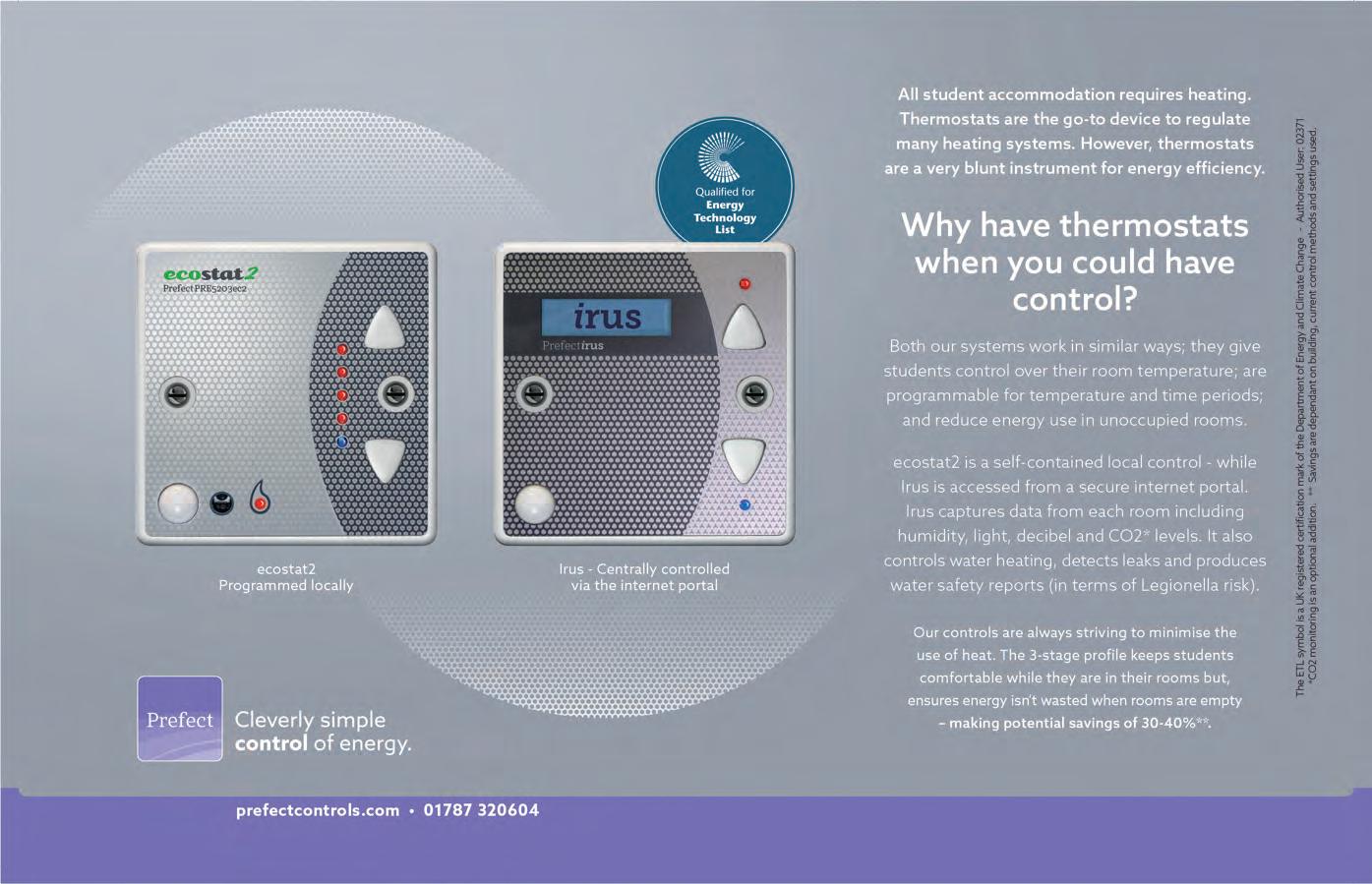
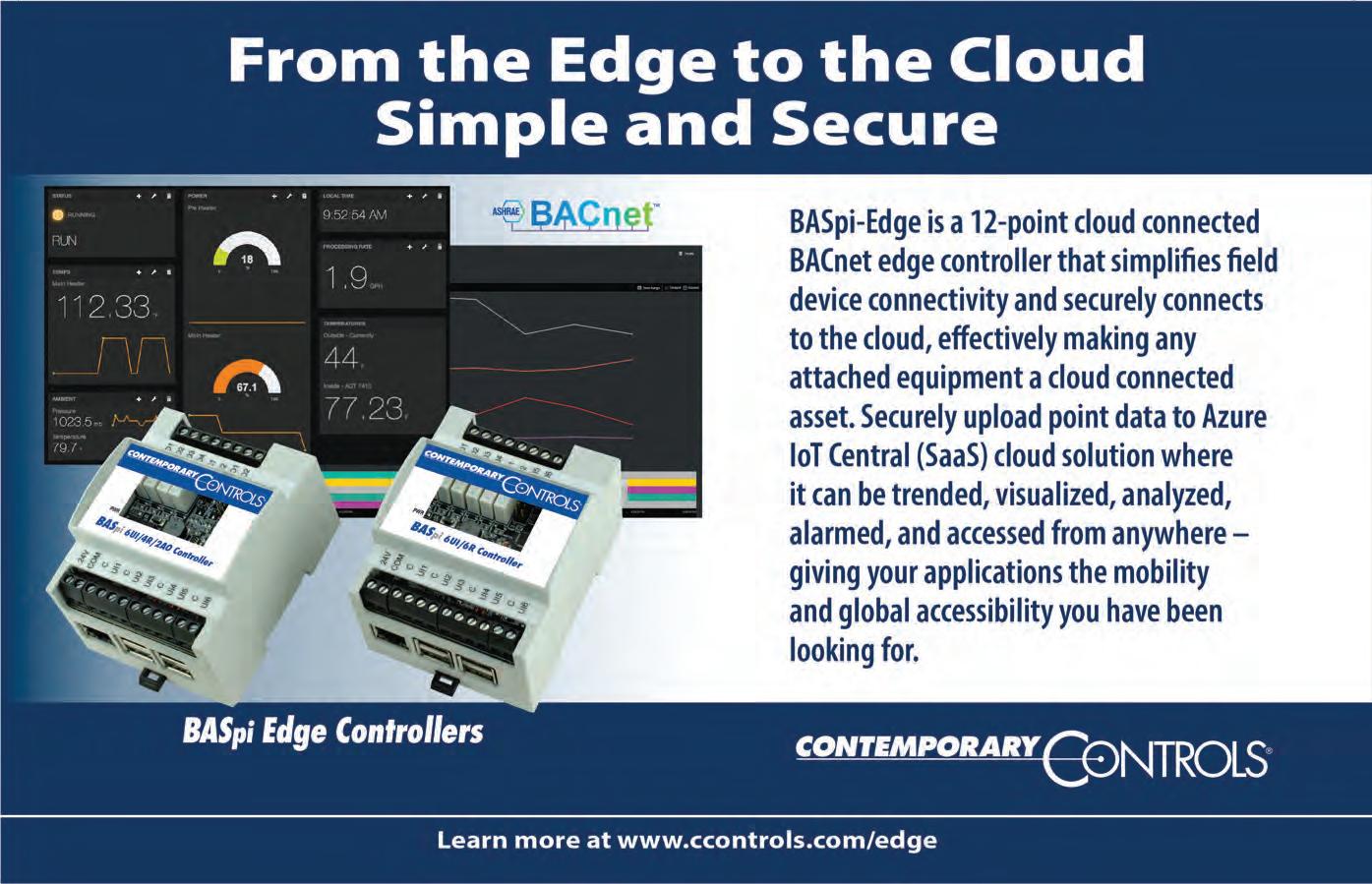

Nick Sacke is head of IoT and products at Comms365
Smart Buildings
For further information on Comms365 visitwww.eibi.co.uk/enquiriesand enter ENQUIRY No. 138
Making social housing smart
Nick Sacke looks at the ways in which IoT can be used to create smarter, safer social housing. But clever and careful planning is required to make the most of the technology
As the demand for more affordable social housing increases across the UK, the pressure is on for social housing associations to adapt to a dynamic, challenging landscape. Accessibility, rising maintenance costs and tenant safety are just some of the everyday challenges facing both housing associations and their tenants. And with the rollout of smart technology taking place in allied industries, the opportunity for IoT technology in social housing can be transformative, with the potential to make developments safer, more energy-efficient, and therefore cheaper to run.
Organisations are already implementing smart technology into their offices and consumers are doing the same in their homes – social housing associations (HA) aren’t far behind. There are several pilot projects and proof of concept trials being rolled out by HAs, and the initial results are encouraging. However, despite common operational challenges across the sector, not one technology solution fits all scenarios. This means that stakeholder education and a number of considerations need to be addressed in the planning phase before the work can begin.
Smart sensors can be used to measure and gather data from a number of property management parameters including temperature, humidity, carbon dioxide levels, noise and people movement. This data can then be shared with providers who can feed it into the network, benefiting not only tenants who can control their usage and bills through increased via access to applications on their smartphones, but also HAs, who can use the data insights for predictive maintenance, allowing for operational agility and highly effective resource allocation. For example, sensors can identify whether humidity levels are creating an environment for damp and

Social housing associations are beginning to see the benefit of implementing smart technology
mould, which if left, would not only incur repair costs but also potentially cause health issues, leading to more expenses over time, such as insurance claims.
It isn’t just housing associations that are turning to IoT technology and accessing the rich data that can be harvested from sensor networks. Several councils and local authorities in the UK are rolling out their own IoT deployments for use cases that include predictive maintenance and a very large cost centre - healthcare and assisted living. By using a variety of sensors tracking movement, appliance usage, fridge access, toilet flushing, heating and water use, care professionals can build profiles of activity that can provide insight into daily patterns and through algorithms, an alert to any changes - affording councils an extra layer of protection for the elderly and vulnerable tenants in their housing estates.
The greater the volume of data harvested from individual properties, the more trending and predictive analysis can be undertaken, leading to enhanced accuracy and forecasting, combined with new data visualisation techniques. And deploying the IoT programme in phases will ensure that audit trails are in place to determine areas that may require adjustment.
Common communications
A key consideration in the deployment of multiple IoT devices is that they are able to utilise a common communications network infrastructure to connect and deliver data to applications in the cloud. Standards in Low Power Wide Area Networks such as LoRaWAN and Narrowband IoT have now emerged globally, and are helping diverse device manufacturers to produce products that conform to these communications protocols, making large deployments easier to deploy and manage in large geographic areas. This enables large-scale coverage and a holistic view across estates of devices and dwellings, some of which are in the tens of thousands per HA. If these standards and methods are followed, overheads for device management and reporting can indeed be minimised.
Another important consideration, which can become a significant barrier to adoption within the social housing market, is cultural acceptance of ‘smart’ technology in the home environment. Despite the operational and cost efficiencies of IoT, for tenants, privacy is a prime concern. The idea of 24/7 monitoring can make tenants nervous, especially when it comes to the issue of data protection; which may affect their willingness to embrace, or even approve the use of these devices in their homes. This, therefore, is an area that HAs need to be mindful of and ensure they are addressing and exploring in the planning phase in order to pre-empt any tenantrequested adjustments to design, deployment, and use of data.
With the demand for more energyefficient housing on the rise and the latest government green standard for new build homes already in place, the expectation for more intelligent homes is certainly increasing. In light of this, we predict that in the years to follow, IoT-based property services will be much more agile, responsive and offer a dynamic set of services that are more tailored to tenants’ needs. Properties that are better managed and highly costefficient to run result in happier, safer tenants. Providers are actively developing more sensors with widerranging capability, connectivity and deployment at scale The vision and objective for this type of technology intervention is to allow housing stock to connect seamlessly to facilities management and operations, exchange relevant data for insight and action, and deliver safer, smarter, economical and environmentally conscious social housing.
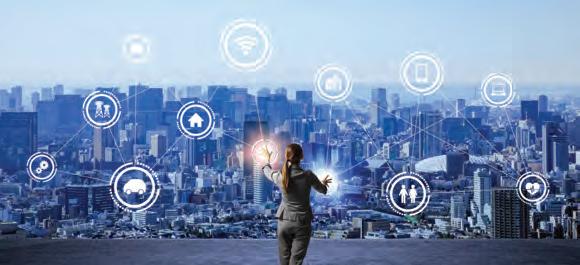
Smart Buildings
For further information on Carlo Gavazzi visitwww.eibi.co.uk/enquiriesand enter ENQUIRY No. 133
William Darby is managing director of Carlo Gavazzi UK
Metering the transition to net zero
The move from fossil fuels to low-carbon electric heating and electric vehicles will make accurate electricity metering critical to the green industrial revolution, says William Darby
Britain’s transition to a cleaner low-carbon future took a step forward in November with Prime Minister Boris Johnson’s announcement of a target to install 600,000 heat pumps every year by 2028, as part of a Ten Point Plan for a green industrial revolution.
Alongside the government’s ambitious plans to decarbonise the heating of new homes and business premises, the plan also included a commitment to decarbonise transport with a ban on the sale of new internal combustion engine cars and vans by 2030.
The move to an electric, low carbon future will increase the demand for metering to ensure both the accurate monitoring of electricity consumption in order to allocate energy costs and for customer billing.
A key element of the Ten Point
Plan is a £1.3bn investment in electric vehicle (EV) infrastructure to accelerate the rollout of charge points for electric vehicles in homes, streets and on motorways.
This will be a major challenge: the
Society of Motor Manufacturers and Traders estimate that Britain will need 2.8m roadside charge points in addition to those in homes and offices.
Charging stations consume significant amounts of electrical power when EV drivers refuel their vehicles. The amount of power consumed needs to be metered to ensure fair and accurate cost allocation for the energy consumed in charging each vehicle.
The Automated and Electric
Vehicles Act 2018 (AEV Act) requires all charge points sold or installed in the UK to have smart functionality, which includes the ability to monitor and record
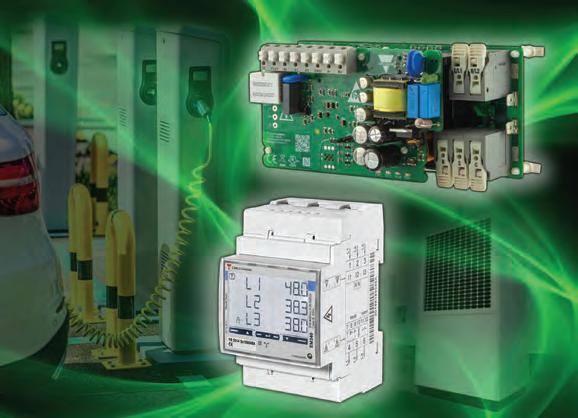
The move to an electric future will boost the demand for accurate metering and cost allocation
energy consumption. There is already a similar requirement for public charge points under the Alternative Fuels Infrastructure Regulations 2017: these require an infrastructure operator to ensure that all recharging points “incorporate intelligent metering systems.”
An ‘intelligent metering system’ means “an electronic system that can measure energy consumption, providing more information than a conventional meter and can transmit and receive data using a form of electronic communication.”
Fast-charge points
For three phase applications, such as public fast charge points, Carlo Gavazzi’s EM340 or EM24-E1 energy analyser are the perfect solution. Both meters are MID certified making them suitable for cost allocation and sub-metering and for fiscal/legal sub-billing for commercial and residential three phase EV charging applications.
Alongside its commitment to greener transport the government has also committed to making the heating of homes, schools and offices greener and more energy efficient with its ambitious target to role out both air source and ground source heat pumps.
Most of the 600,000 heat pumps set to be installed every year by 2028 will be in new-build homes, which will no longer be permitted to use gas for heating. However, increasing numbers of heat pumps will be installed in existing homes and businesses, where they will replace gas or oil-fired boilers.
The installation of heat pumps in existing properties is currently supported by the Domestic and Non-Domestic Renewable Heat Incentive (RHI) which, for the purposes of this scheme, includes a heat pump installation that supplies more than one dwelling.
From 22 May 2018, any heat pump installed under the Domestic RHI must have electricity metering arrangements in place to enable its performance to be monitored. All such meters used to claim payment under the RHI need to comply with the 2014 EU Measuring Instruments Directive (MID) and fall within accuracy Class A, as defined in Annex MI-003 of the MID.
Some heat pumps have built-in meters and monitoring devices, known as ‘on-board meters’. An on-board electricity meter is integrated into the heat pump. Another metering option is to use a standalone electricity meter that measures the electricity consumption of your heat pump. The electricity meter will likely have to be purchased in addition to the heat pump and be installed alongside it.
For single phase new heat pump metering applications, Carlo Gavazzi’s EM100 series of energy meters offer a cost effective, compact and MID certified solution. While the EM300 series is an MID certified meter for 3-phase suitable for both commercial and domestic applications.
Where accurate meters need to be retrofitted to existing heat pumps, Carlo Gavazzi have additional solutions within its EM100, EM200 and EM300 range depending on requirements and preference. All meters are ideal for measuring energy consumption and the main electrical variables of single-phase or three-phase loads.
The Domestic RHI is set to end on 31 March 2022, after which financial support for domestic heat pump installations will be covered under a new Clean Heat Grant scheme. This will target support to existing households and small non-domestic buildings to facilitate the installation of heat pumps. As with the RHI, accurate metering of electricity consumption by the heat pump will be key to ensuring the success of the new scheme.
It is clear that ditching gas and oil heating in favour of cleaner, greener electric heat pumps will have huge environmental benefits. These benefits can be further enhanced by extending the lifetime and reliability of the heat pump compressor motor by eliminating the start capacitor. Carlo Gavazzi’s High Dynamic Motor Starter (HDMS eliminates the need for a starting capacitor altogether.







